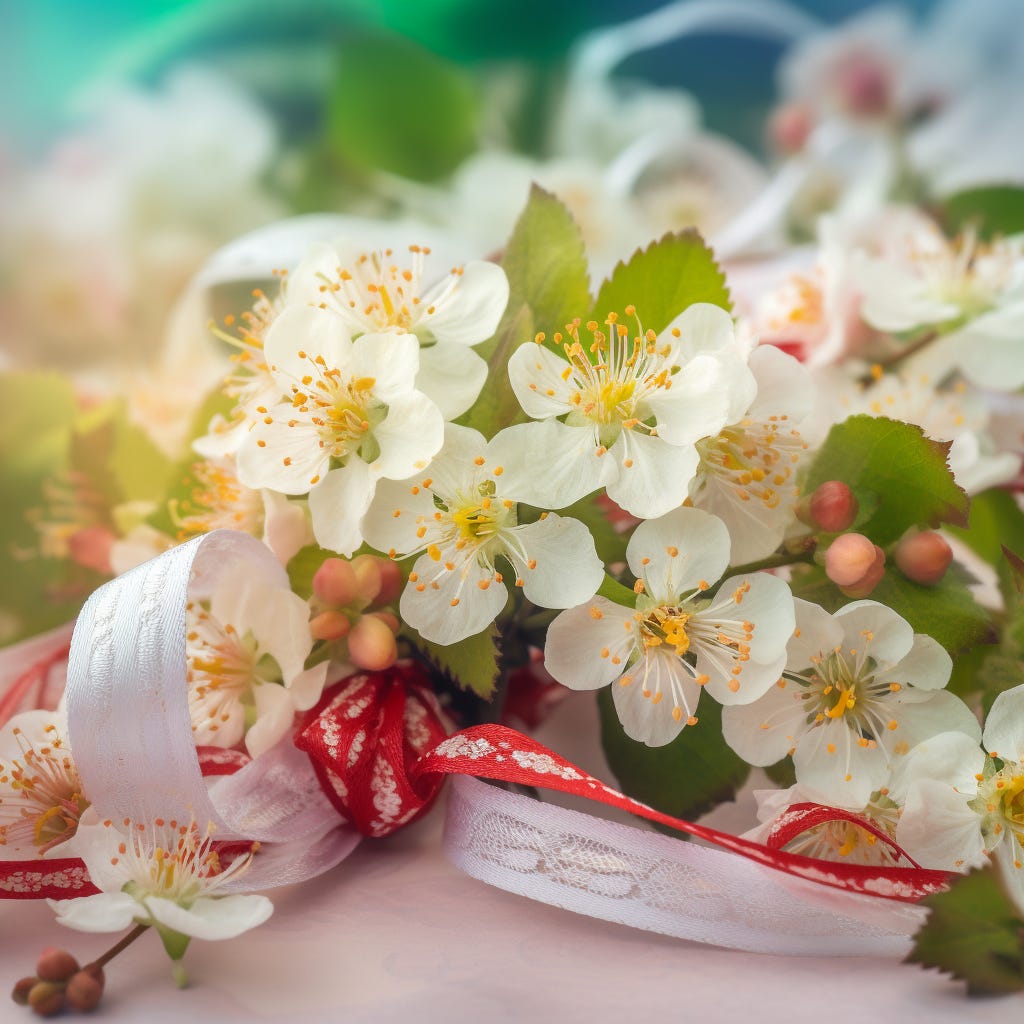
Beltane arrives in all its Spring glory next week and the Halloween decorations are ‘springing’ up everywhere, much to my delight (and some amount of seasonal dissociation). I mentioned in the previous article Beltane - Part 3: Water, that part of my private and personal celebrations for Beltane includes bathing in the early morning dew from a blossoming hawthorn tree. I also tie clooties (strips of cloth or ribbons) into the branches and I will bring home one of its blossom-laden boughs (with its permission) decorating it with colourful ribbon and tying it to a post on the front verandah, reviving a very old Beltane/May Day tradition. In this final article exploring Beltane, we take a look at the earthy delights of this Spring celebration including the tradition of going ‘a-Maying,’ garlanding, bringing in the May Bush and dancing the May Pole.
‘A-Maying’
Waaken chaps and wenches gay,
An' off t’country to gather May
Staffordshire Customs, Superstitions and Folklore, 1924As with the Beltane traditions of dew bathing and visiting springs and wells, which we learnt about in the previous article, Beltane - Part 3: Water, the tradition of going ‘a-Maying’ was commonly practised across Europe on the first day of May. Merry parties and picnics were held in wild forests and fields, girls and young women made flower wreaths and braided flowers into their hair, boys and young men competed against each other in impromptu games.
This scene was famously described in Thomas Malory’s Morte D’Arthur (The Death of King Arthur), when Queen Guinevere and her entourage spent the morning in the May woods and came home “bedashed with herbs, mosses and flowers, in the best manner and the freshest”.


May Day was also a time for young lovers to tryst or pledge their troth. Christian leaders bemoaned the improprietous behaviour that accompanied May Day celebrations and bawdy songs, filled with double-entendre and metaphors for making love/having sex were written and sung.
Now is the month of Maying
Now is the month of maying,
When merry lads are a playing, fa la,
Each with his bonny lass
Upon the greeny grass. Fa la.
English Ballad by Thomas Morley, England,1595A Pleasant Country Maying Song 1629
Thus the Robin and the Thrush,
Musicke make in every bush,
While they charm their pretty notes,
Young men hurle up maidens cotes
In ‘The Pepys Ballads’, edited by Hyder Edward Robbins, Cambridge 1929Garlanding
In the 15th Century in England, women and young girls would make money from the displaying and selling of May garlands. This tradition was taken up by schools and expanded into processions. Young girls usually, but sometimes young boys too, dressed in May Day finery, decked in ribbons and flowers, carrying displays of flowers and greenery, and went door to door collecting money for their school. In some regions they also sung May carols, crowned a May Queen or danced with Jack in the Green. A person dressed as Jack in the Green would dance, and cavort in some May Day processions, wearing a conical or pyramid-shaped costume made of wicker or wooden frame covered in green foliage. These traditions are being revived and it is now common to see May Day processions in towns, hamlets and cities throughout England and the British Isles.
In many countries around Europe, May Day has become a focal point for the Labour movement, marking the day as a Labour Day public holiday, with some countries and individual cities holding Labour Day marches.
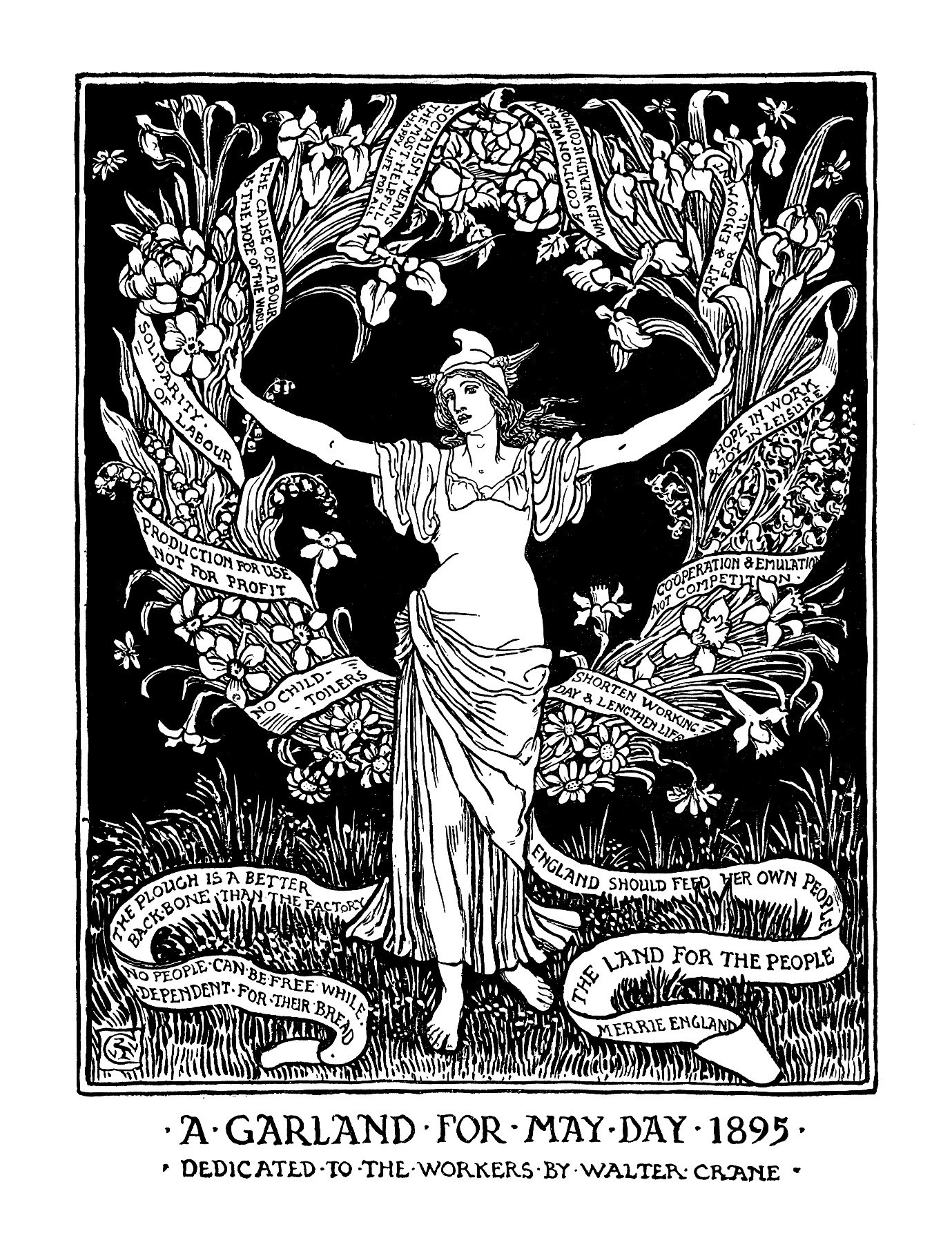
May Bush
All in this pleasant evening, together come are we,
For the summer springs so fresh, green and gay;
We’ll tell you of a blossom and buds on every tree,
Drawing near to the merry month of May.
English Maying Song, year unknownFlowers and greenery were gathered to decorate houses and churches across the European countryside, as well as ship’s masts throughout fishing towns. Where flowers and greenery were difficult to come by such as in cities or industrial towns, colourful ribbons were cheerfully substituted. Branches from different flowering trees or bushes were placed on the doors of houses, different species holding various meanings according to local custom. The most favoured was the blooming hawthorn, while others such as sloe, elder, crab-apple, nettle and thistle were, in some places, marks of insult.
Youth’s folks now flocken in everywhere
To gather May baskets and smelling brere
And home they hasten the posts to dight
And all the Kirks pillars ere daylight
With hawthorn buds and sweet eglantine
And garlands of roses and sops in wine
Edmund Spence, English poet, 16th century‘Long Life, a pretty wife and a candle for the May Bush’ was a rhyme recounted by children in Dublin when looking for a contribution of candles, money or sweets for their May Day festivities. National Museum of Ireland
The Hawthorn Tree
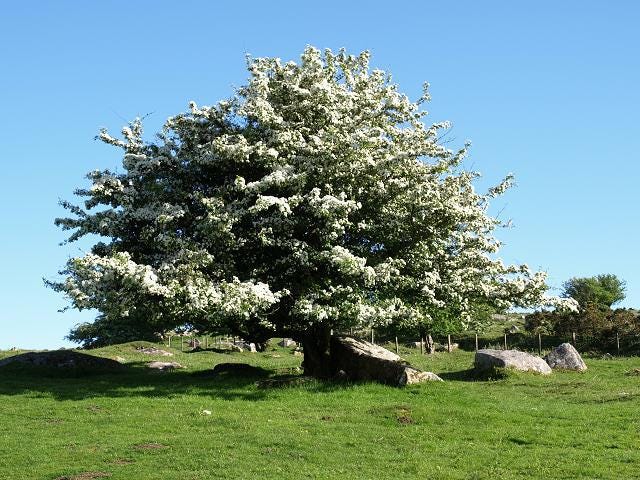
The hawthorn tree, Crataegus sp., often known as the May tree or whitethorn, is a small, deciduous tree native to Europe, North America, and parts of Asia. It is a richly symbolic tree and holds great significance in various cultures and traditions.
In Celtic Druidic tradition, it is represented in the Ogham alphabet by the Ogham letter Huath, which stands for dualities, change and liminal space and was associated with protection and transformation. Due to their long and sharp thorns, hawthorns often served as a natural boundary or hedge, providing a protective barrier against negative energies and enchantments. Hawthorn is still one of the most important hedgerow plants that mark the boundaries between fields and properties throughout the British Isles.
In Eastern European cultures, the hawthorn was also considered a symbol of protection and healing and was often planted near homes to ward off evil spirits and protect against curses. Additionally, the hawthorn was associated with fertility and good luck. Its blossoms were sometimes used in rituals and celebrations related to love and the arrival of spring.
In the Celtic nations, and Ireland in particular, the hawthorn tree has long been associated with the realm of fairies, particularly those trees standing alone in open fields or near sacred springs or wells. It was believed that these trees were inhabited by the sidhe, also known as the good people or fairy folk. Angering the fairies by cutting down their sacred home is still believed to bring misfortune. Many tales caution against disturbing these trees, and superstitions related to hawthorns often deter people from harming them even now. It is still considered unlucky to cut hawthorn wood or bring the blossoming boughs into homes or under rooves, except on May Day.
Hawthorn also has a long history of medicinal use, particularly in traditional herbal medicine. It is renowned for its ability to heal heart and circulation problems. The berries, leaves, and flowers of the hawthorn tree are used to make extracts, teas, and tinctures. These herbal remedies are believed to support cardiovascular health, help regulate blood pressure, and improve blood circulation. Additionally, hawthorn has been used to alleviate symptoms of anxiety and aid in digestion. It is also considered a symbol of hope and protection in herbal lore, providing physical and spiritual nourishment.
Maypole
Maypoles and dancing the Maypole were once common May Day customs throughout Europe and European colonies. Maypoles are tall wooden poles, decorated with flower garlands, ribbons, and streamers, erected in fields and commons, around which communities danced, feasted and drank together.
They have twenty or forty yoke of oxen, every ox having a sweet nose-gay of flowers placed on the tip of his horns, and these oxen draw home this Maypole… which is covered all over with flowers and herbs, bound about with strings, from the top to the bottom, and sometimes painted with variable colours, with two or three hundred men, women, and children following it with great devotion. And thus being reared up, with handkerchiefs and flags hovering on the top, they strew the ground around about, bind green boughs about it, set up summer halls, bowers and arbours hard by it. And then they fall to dance about it.
Philip Stubbes, 1580s in ‘The Stations of the Sun: a history of the ritual year in Britain’ by Ronald Hutton, 1996, p. 234
Competing villages often attempted to steal each other’s maypoles, a tradition usually undertaken in the spirit of misrule fun, but which sometimes resulted in violence.
Festivities featuring the maypole were most commonly found in the southern regions of the British Isles and Germanic countries as well as throughout Slavic Europe. They are also a prominent feature of Swedish midsummer celebrations, where they are called midsommarstang. Maypoles did not generally feature in the Gaelic regions where the fire ceremonies dominated Beltane celebrations.
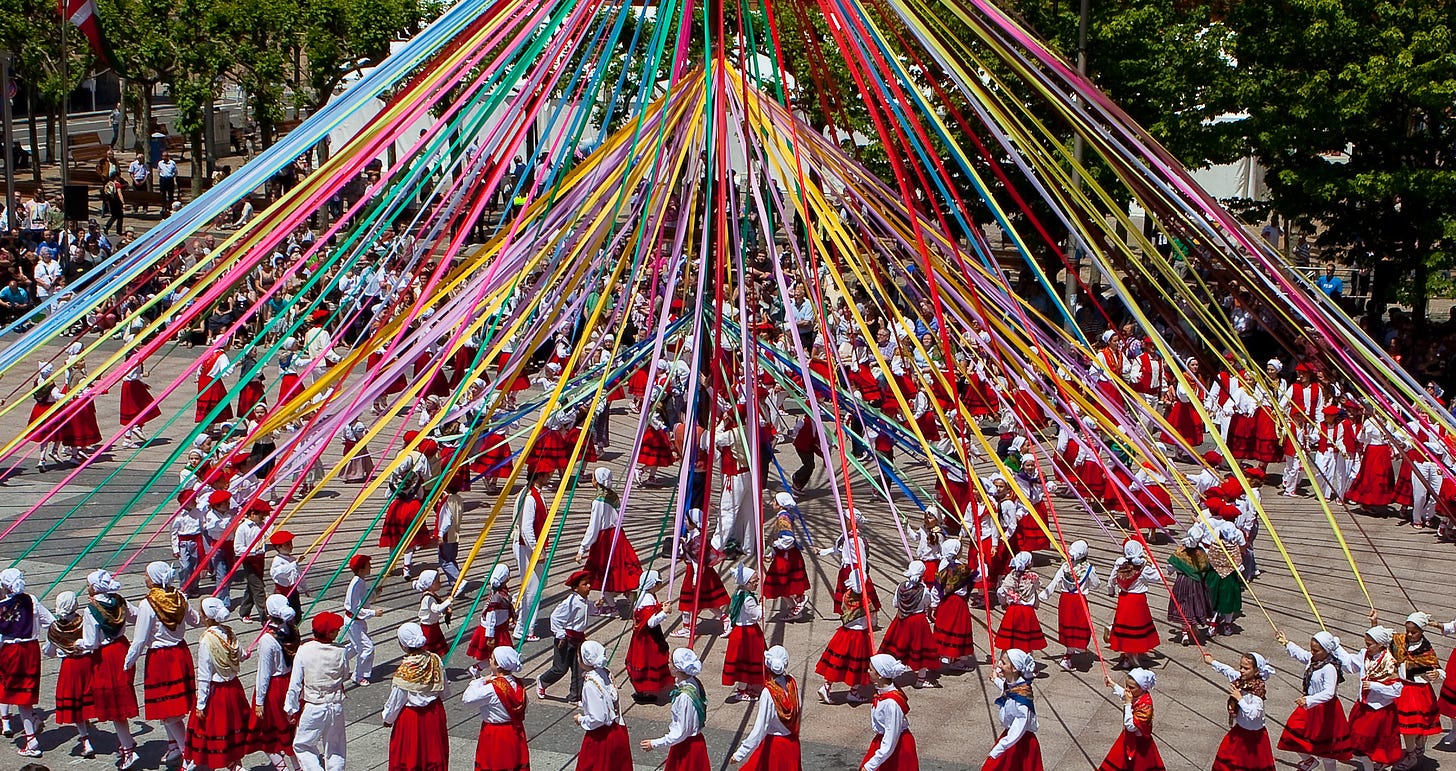
In Germanic countries, the maypole is called maibaum (May Tree) and the dancing is known as Tanz in den Mei. Dances could be as simple as wrapping ribbons around the maypole or as complicated as weaving patterns or creating a ‘gypsy tent.’
The video (0:56 mins) below shows students from the Archer School for Girls participating in their annual Maypole Dance in 2019.
Maypole dancing became popular in Australia and New Zealand during the late 1800s and was performed until the 1960s at ‘sports carnivals, picnic days and special events such as Empire Day and the Annual Combined Public Schools’ Display at the Sydney Cricket Ground’ (NSW Schoolhouse Museum of Public Education, 2013).
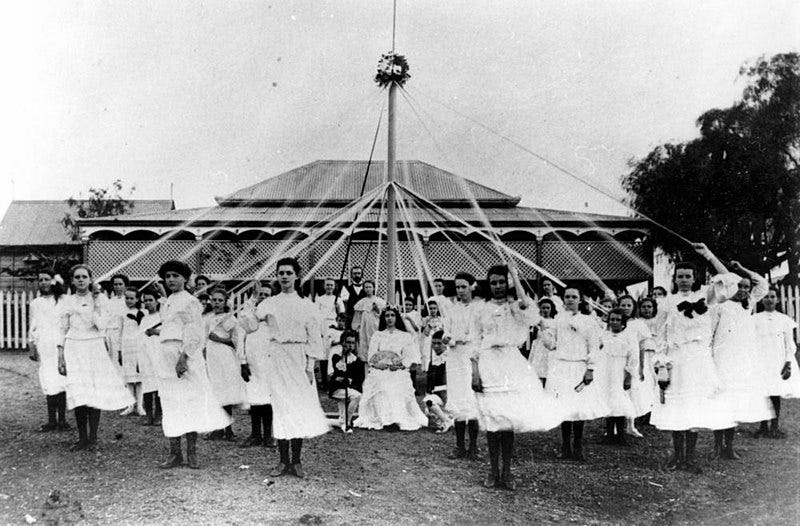
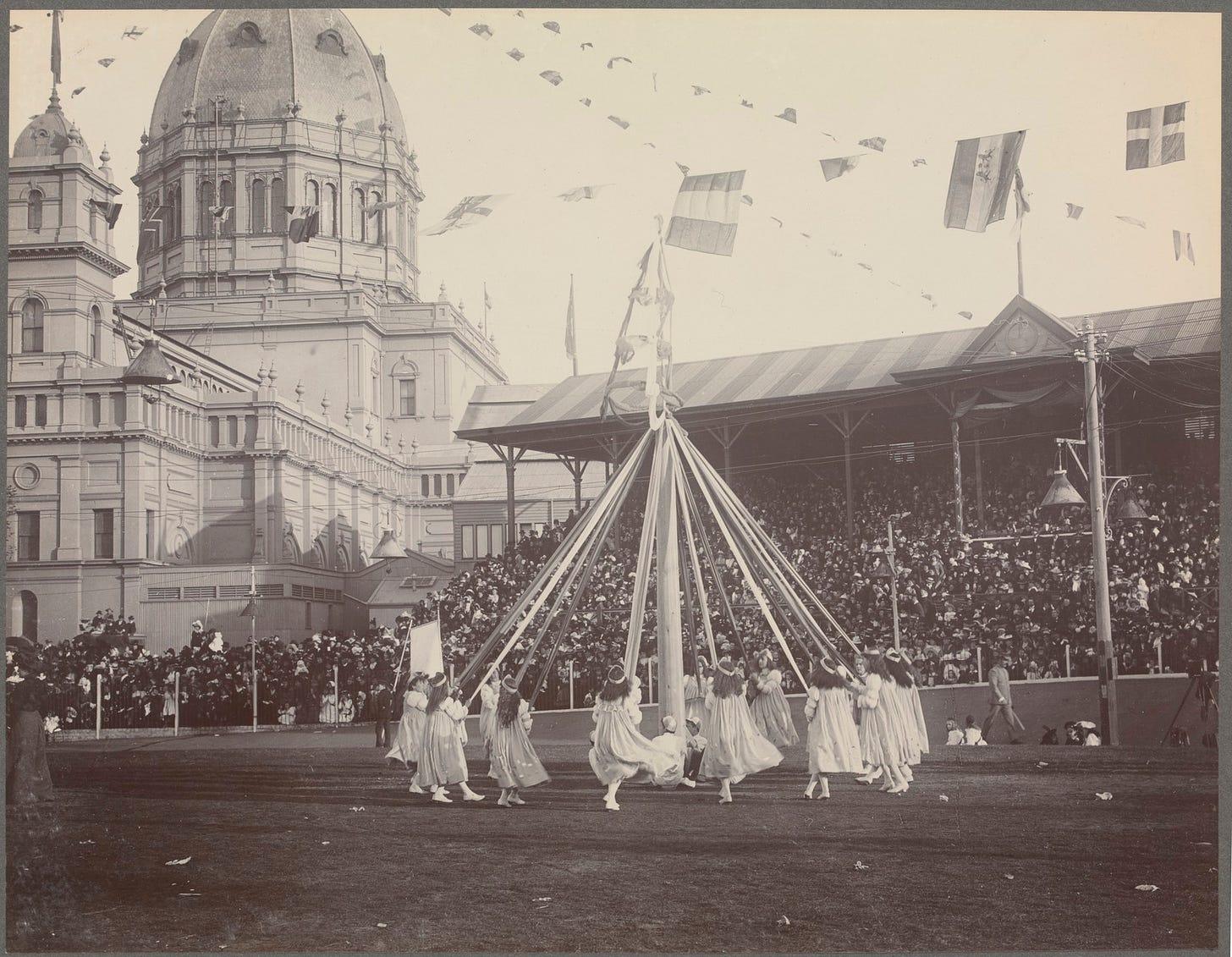
The video (11:18 mins) below from the National Museum of Ireland is very informative about the traditions related to May Day in Ireland.
I hope you enjoyed these four articles on Beltane traditions and that you are looking forward to some fun trick-or-treating next week. If you are in the Southern Hemisphere you might like to incorporate some seasonal themes into your ‘Halloween’ decorating and costumes by celebrating the witch with flower wreaths adorning witches’ hats and colourful ribbons tied to broomsticks. Decorate skulls and skeletons with flowers and colour.
Why not find a blossoming hawthorn and tie clooties into its branches? Or decorate a nearby tree with colourful ribbons and flower trinkets? Take a hawthorn branch (with permission) home, decorate it with colourful ribbons and tie it to your front verandah/porch post. Get some friends and family together for a picnic in a forest or a field or even get your community together and bring back the tradition of Maypole dancing. For a quieter celebration, wake up early and bathe in the early morning dew.
Maybe we can start connecting with the seasons where we live, one person and one small tradition at a time.


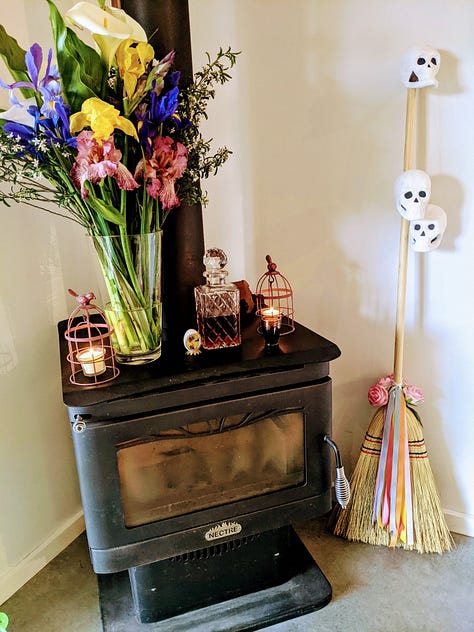
Next week we will break away from European traditions and explore the colourful and exciting Latin American tradition of Dia de Muertos (Day of the Dead). Until then, Waaken chaps and wenches gay, An' off t’country to gather May!




